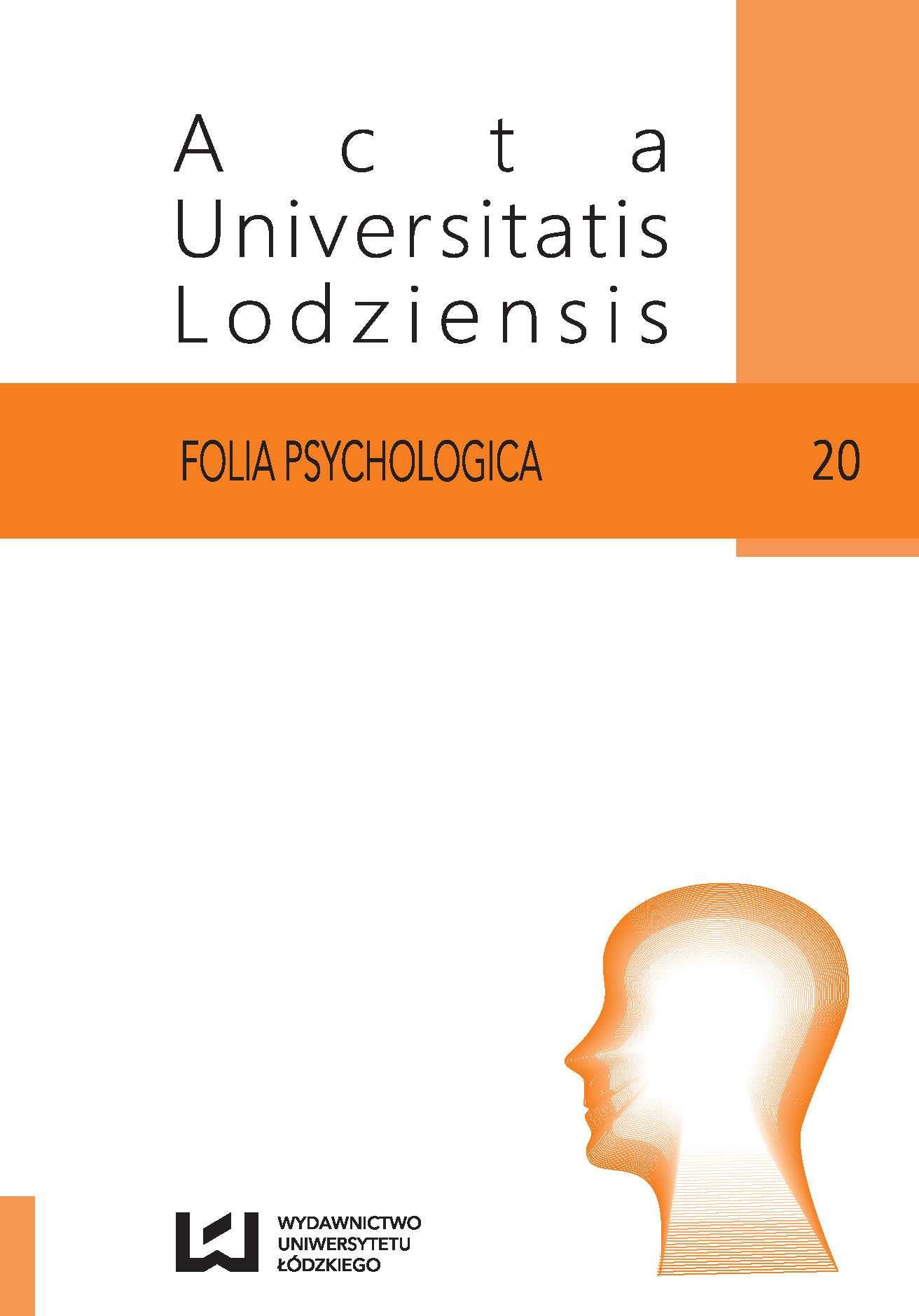Rozpoznawanie stanów emocjonalnych na rysunkach dotykowych twarzy przez kobiety i mężczyzn
DOI:
https://doi.org/10.18778/1427-969X.20.04Słowa kluczowe:
rysunki wypukłe, percepcja dotykowa, emocje, różnice międzypłciowe, wyobraźniaAbstrakt
Przedmiotem badania była analiza zdolności osób widzących do rozpoznawania emocji na rysunkach wypukłych (poznawanych za pomocą dotyku). Materiał badawczy stanowiły rysunki męskich oraz kobiecych twarzy wyrażających: szczęście, smutek, strach, zdziwienie, wstręt i gniew. Wyniki wskazują, że kobiety trafniej niż mężczyźni rozpoznają emocje na podstawie eksploracji dotykowej szkiców wyrazów twarzy. W dyskusji poruszono zagadnienie możliwych źródeł ujawnionej w badaniu różnicy płciowej, wskazując na różnice w funkcjonowaniu inteligencji emocjonalnej oraz w specyfice działania wyobraźni u kobiet i mężczyzn.
Bibliografia
Ciarrochi J. V., Chan A. Y. C., Bajgar J. (2001). Measuring emotional intelligence in adolescents. Personality and Individual Diff erences, 31, 1105–1119.
Google Scholar
Chan J. S, Simões-Franklin C., Garavan H., Newell F. N. (2010). Static images of novel, moveable objects learned through touch activate visual area hMT+. NeuroImage, 49, 1708–1716.
Google Scholar
D’Angiulli A., Kennedy J. M., Heller M. A. (1998). Blind children recognizing tactile pictures respond like sighted children given guidance in exploration. Scandinavian Journal of Psychology, 39, 187–190.
Google Scholar
De Silva L. C., Miyasato T., Nakatsu R. (1997). Facial emotion recognition using multi-modal information. Proceedings of International Conference on Information, Communications and Signal Processing, 1, 397–401.
Google Scholar
Ekman P., Friesen W. V., Hager J. C. (2002). Facial Action Coding System. A human face. New York: Oxford University Press.
Google Scholar
Francuz P., Mackiewicz R. (2005). Liczby nie wiedzą, skąd pochodzą: Przewodnik po metodologii i statystyce nie tylko dla psychologów. Lublin: Wydawnictwo KUL.
Google Scholar
Hall J. A., Matsumoto D. (2004). Gender diff erences in judgments of multiple emotions from facial expressions. Emotion, 4, 201–206.
Google Scholar
Heller M. A. (1989). Picture and pattern perception in the sighted and blind: The advantage of the late blind. Perception, 18, 379–389.
Google Scholar
Heller M. A., Calcaterra J. A., Burson L. L., Tyler L. A. (1996a). Tactual picture identyfi cation by blind and sighted people: Eff ects of providing categorical information. Perception and Psychophysics, 58, 310–323.
Google Scholar
Heller M. A., Calcaterra J. A., Tyler L. A., Burson L. L. (1996b). Production and interpretation of perspective drawings by blind and sighted people. Perception, 25, 321–334.
Google Scholar
Heller M. A., Kennedy J. M., Joyner T. D. (1995). Production and interpretation of pictures of houses by blind people. Perception, 24, 1049–1058.
Google Scholar
Hoffmann H., Kessler H., Eppel T., Rukavina S., Traue H. C. (2010). Expression intensity, gender and facial emotion recognition: Women recognize only subtle facial emotions better than men. Acta Psychologica, 135, 278–283.
Google Scholar
Jakubowski M. (2009). Tyfl ografi ka – Historia i współczesność, metody i technologie. Tyfl oświat, 1, 36–40.
Google Scholar
Kennedy J. M. (1993). Drawing and the blind: Pictures to touch. New Haven, CT: Yale University Press.
Google Scholar
Knopp K. A. (2012). Czy kobiety naprawdę są bardziej inteligentne emocjonalnie niż mężczyźni? O różnicach międzypłciowych w zakresie zdolności emocjonalnych. Kwartalnik Naukowy Towarzystwa Uniwersyteckiego Fides et Ratio, 4, 95–112.
Google Scholar
Kozhevnikov M., Kosslyn S., Shephard J. (2005). Spatial versus object visualizers: A new characterization of visual cognitive style. Memory and Cognition, 33, 710–726.
Google Scholar
Lebaz S., Jouff rais C., Picard D. (2012). Haptic identifi cation of raised-line drawings: high visuospatial imagers outperform low visuospatial imagers. Psychological Research, 76, 667–675.
Google Scholar
Lebaz S., Picard D. (2014). Classifi cation of tactile pictures of expressive faces by blind adults. Terra Haptica, 4, 45–51.
Google Scholar
Lederman S. J., Klatzky R. L., Chataway C., Summers C. (1990). Visual mediation and the haptic recognition of two-dimensional pictures of common objects. Perception and Psychophysics, 47, 54–64.
Google Scholar
Lederman S. J., Klatzky R. L., Renner-May E., Lee J. H., Ng K., Hamilton C. (2008). Haptic processing of facial expressions of emotion in 2D raised-line drawings. IEEE Transactions on Haptics, 1, 27–38.
Google Scholar
Loomis J. M., Klatzky R. L. (2007). Functional equivalence of spatial representations from vision, touch, and hearing: Relevance for sensory substitution. [W:] J. J. Rieser, D. H. Ashmead, F. F. Ebner, A. L. Corn (red.), Blindness and brain plasticity in navigation and object perception (s.s. 155–184). New York: Lawrence Erlbaum Associates.
Google Scholar
Loomis J. M., Klatzky R. L., Giudice N. A. (2013). Representing 3D space in working memory: Spatial images from vision, touch, hearing, and language. [W:] S. Lacey, R. Lawson (red.), Multisensory Imagery: Theory and Applications (s. 131–156). New York: Springer.
Google Scholar
Loomis J. M., Klatzky R. L., Lederman S. J. (1991). Similarity of tactual and visual picture recognition with limited fi eld of view. Perception, 20, 167–177.
Google Scholar
Magee L. E., Kennedy J. M. (1980). Exploring pictures tactually. Nature, 278, 287–288.
Google Scholar
Matczak A., Piekarska J., Studniarek E. (2005). Skala inteligencji emocjonalnej – twarze (SIE-T): Podręcznik. Warszawa: Pracownia Testów Psychologicznych PTP.
Google Scholar
Merry R. V., Merry F. K. (1933). The tactual recognition of embossed pictures by blind children. Journal of Applied Psychology, 17, 148–163.
Google Scholar
Pathak K., Pring L. (1989). Tactual picture recognition in congenitally blind and sighted children. Applied Cognitive Psychology, 3, 337–350.
Google Scholar
Picard D., Jouff rais C., Lebaz S. (2011). Haptic recognition of emotions in raised-line drawings by congenitally blind and sighted adults. IEEE Transactions on Haptics, 4, 67–71.
Google Scholar
Szubielska M. (2014). Strategies for constructing spatial representations used by blind and sighted subjects. Studia Psychologica, 56, 273–285.
Google Scholar
Thompson L. J., Chronicle E. P., Collins A. F. (2003). The role of pictorial convention in haptic picture perception. Perception, 32, 887–893.
Google Scholar
Vecchi T. (2001). Visuo-spacial processing in congenitally blind people: is there a gender-related preference? Personality and Individual Diff erences, 30, 1361–1370.
Google Scholar
Wijntjes M. W. A., van Lienen T., Verstijnen I. M., Kappers A. M. L. (2008). The infl uence of picture size on recognition and exploratory behaviour in raised-line drawings. Perception, 37, 602–614.
Google Scholar









